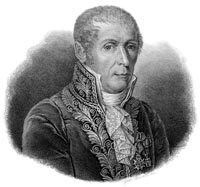
| Born: Feb 18, 1745 in Como, Duchy of Milan (present-day Italy) |
| Died: Mar 5, 1827 (at age 82) in Como, Lombardy-Venetia(present-day Italy) |
| Nationality: Italian |
| Famous For: Invention of the electric cell, Discovery of methane, Volt, Voltage and Voltmeter |
Alessandro Volta was an Italian physicist. He was especially active in pioneering the scientific study of electricity, and the volt is named in his honor. Volta was also the first scientist to produce a working battery, which he referred to as a “voltaic pile.” He remains highly regarded in his native land, and his image has been used on both stamps and currency.
Early Life
Volta was born in the northern town of Como, Italy on February 18, 1745. His childhood was unremarkable, and his first job of real note did not come until 1774, when he was appointed as professor of physics in his home town’s Royal School. The following year, he produced a highly successful device which created static electricity, drawing on the previous works of the Swedish scientist Johan Wilcke. Volta energetically promoted his improved device, to the extent that many people believed he had originated the very concept.
Volta then became interested in gas chemistry, discovering methane in an Italian lake in November 1776 and successfully isolating it two years later. He had been inspired to search for the gas after reading a paper written by the American polymath, Benjamin Franklin. Volta also set up experiments in which methane, while held in a sealed container, could be set alight by means of a spark of electricity.
Further Electrical Studies
Volta was a pioneer in the study of what is now known as capacitance. His work was instrumental in the scientific community’s choice of the term “volt” for the now well-known unit of electrical charge. In 1779, he was appointed to the University of Pavia’s chair in experimental physics. He was to remain in this post for more than two decades. While there, he married his wife, Teresa, and the couple had three sons together.
He became interested in the experiments that Luigi Galvani was carrying out with frogs, which showed that they could both conduct and detect electricity. Volta tried replicating the experiment with paper soaked in brine, rather than frogs’ legs, and was able to detect the flow of electricity in this way as well. From this he discovered the law by which electromotive force is determined by the difference between the potentials of two electrodes.
The First Battery
In 1800, Volta and Galvani had a quarrel regarding one of Galvani’s theories. To help show that he was in the right, Volta developed his “voltaic pile,” which was able to output an electric current on a steady basis. This was the first modern battery. While experimenting to discover the best pair of metals to use for his electrodes, Volta settled upon silver and zinc. The finished voltaic pile saw the electrodes pressed against brine-soaked cardboard, although early versions of the battery had the brine placed into goblets.
Volta’s battery, although effective, was not suitable for general use in the long term. This was partly because of its reliance on sulfuric acid, a highly dangerous and corrosive substance. Nevertheless, his achievement saw him ennobled by Napoleon Bonaparte in 1801. In 1819, Volta decided to retire from active science, spending the remainder of his days living quietly on his country estate in Camnago. He died at home on March 5, 1827. A museum by Lake Como commemorates Volta’s life and works.